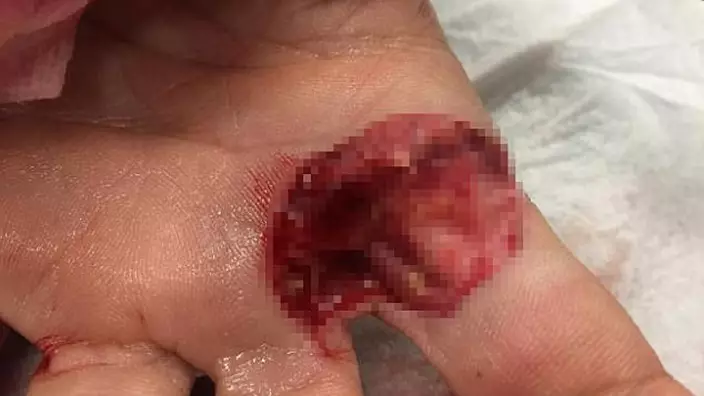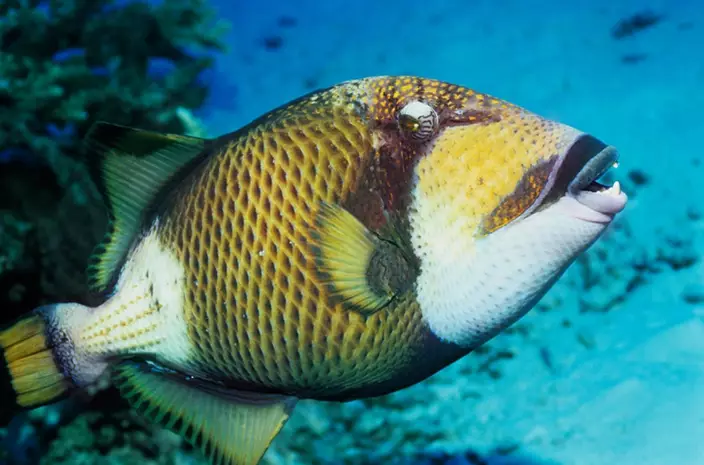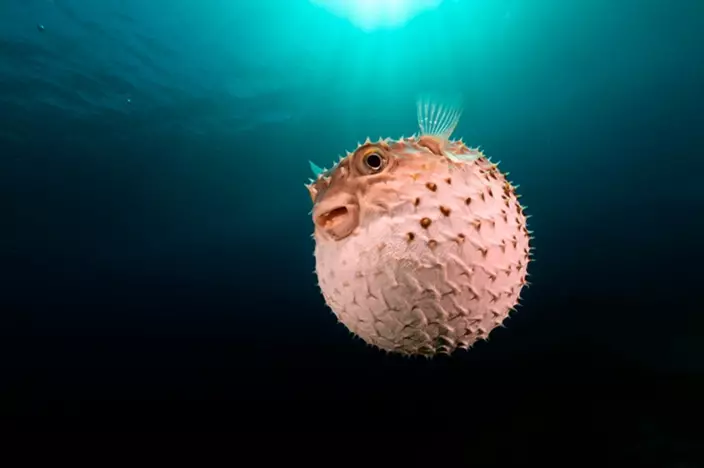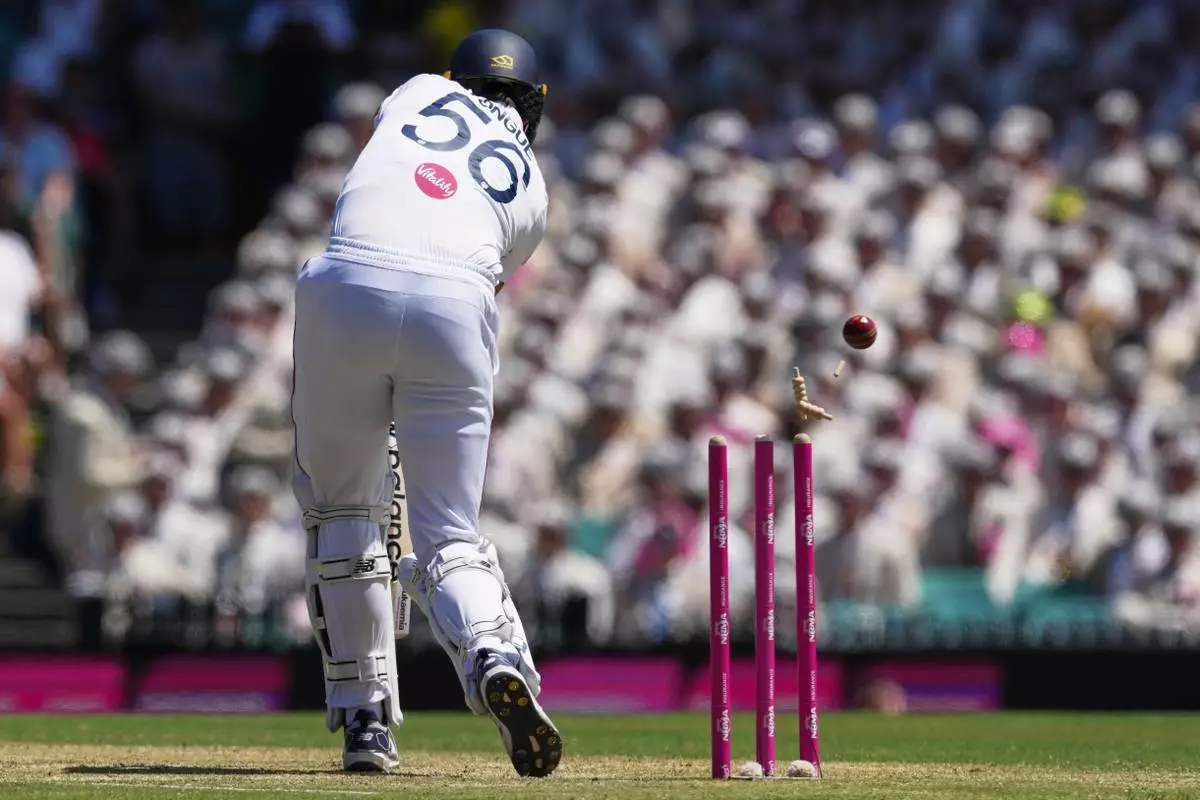Be aware of hidden dangers around water - A tiny fish could also kill you.
A woman in Australia mauled by a coral reef fish after 10 seconds in the water has required a skin graft for the gruesome wound.
Click to Gallery
Triggerfish/Designed Photo
Pufferfish/Designed Photo

Online Photo
Julie Pochet, from Port Douglas in tropical far north Queensland, had just dived into the water at a local beach on November 26 when a fish bumped into her ribs. When the fish swam towards her, she reached her hand out of curiosity and it attacked, taking a chunk out of her hand.

Online Photo
Pochet immediately jumped out of the water and went to the tap to rinse it. She also asked a tourist to run to the restaurant to get pepper — an old cook's trick — to stop the blood from flowing out. But the bite was so severe that it had damaged her nerve ends. She ended up getting a skin graft in the hospital.

Triggerfish/Designed Photo
Pochet was wearing a coral swimsuit at the time and thinks the fish may have confused her with live coral. She described the creature as a dark-colored fish that looked like a wrasse and was the size of a parrotfish.

Pufferfish/Designed Photo
Professor David Bellwood, a coral fish expert, suspects the fish was either a triggerfish or a puffer fish. Both species are known to bite humans and are common in tropical shallow waters. He warns swimmers to be extra careful.
SYDNEY (AP) — Joe Root posted his second hundred of the series for England and Travis Head closed in on his third for Australia as Day 2 of the final Ashes test closed evenly poised on Monday.
England was bowled out just before tea for 364 at the Sydney Cricket Ground, with Root leading with a masterful 160 for his best test score in Australia from his four Ashes tours.
At stumps, Australia was 166-2 in reply with Head again in imperious form as he slashed his way to 91 not out from 87 balls.
Ben Stokes took both wickets for England, which struggled to stem the flow of runs in the evening session before the wicket of the well-set Marnus Labuschagne late in the day.
Root showed all the composure of a 163-test veteran as he notched his 41st century off 146 balls, with 11 boundaries and celebrated with the same shrug gesture as when he broke through for his first hundred in four Ashes tours at Brisbane last month.
Australia retained the Ashes with wins in the first three tests, but England is coming off a drought-breaking win in the fourth test at Melbourne last week.
“I just felt like we’ve had some amazing support throughout this series and we’ve not been able to achieve what we set out to as a group, but at no point has that (support) ever wavered,” Root said. The celebration "is a way of saying thankyou.”
Root’s innings finally ended when he popped a return catch to Michael Neser, who dived across the pitch to grasp the ball just inches above the ground.
While his disappointment was evident as he walked from the field, he received a standing ovation from the near-capacity Sydney Cricket Ground in what may be his last tour of a country that had provided his greatest batting challenge.
Root is now level with former Australia captain Ricky Ponting on the all-time list of test centurymakers. Only Sachin Tendulker (51) and Jacques Kallis (45) have more.
Scott Boland and Mitchell Starc made early breakthroughs Monday after Root and Harry Brook’s partnership had moved to 169 runs and was threatening to take the test away from the hosts.
Boland (2-85) ended Brook’s equal parts streaky and sublime innings at 84, with Steve Smith taking a sharp catch to bring to a close the best partnership of the series across both teams.
Starc (2-93) removed England skipper Stokes (0) for the fifth time this series with a near unplayable delivery that shaped away from the left-hander which took a thin edge on its way through to Alex Carey.
Jamie Smith made an enterprising, and at times fortunate, 46 before he holed-out to the part-time medium pace of Labuschagne.
Root and Jacks then combined for 54-run partnership before Neser's (4-60) three quick strikes wrapped up the innings.
Australia's innings got off to a fast start with Head and Jake Weatherald raising 50 in just the 10th over.
Stokes (2-30) entered the attack to stem the runs and soon had Weatherald (21) trapped lbw to have Australia at 57-1.
Head continued the attack and raised his 50 from 55 balls and soon after passed 500 runs for the series, at a strike rate above 87.
“Every ball he (Head) is looking to score,” Neser said. “He is not trying to work it around or grind it out. And most times he creates more opportunities than normal batters, because he is so talented.”
Labuschagne also found form and with Head plundered a 105-run partnership in quick time.
In the fading light, Labuschagne and Stokes had a verbal exchange across several overs with the England captain showing and voicing his displeasure at the Australian's delaying tactics.
Stokes eventually had Labuschagne (48) caught at gully and Australia was 162-2.
Neser went in as nightwatchman for 15 minutes and took a painful blow on the elbow in the final over.
AP cricket: https://apnews.com/hub/cricket

Australia's Marnus Labuschagne reacts after he was dismissed during play on day two of the fifth and final Ashes cricket test between England and Australia in Sydney, Monday, Jan. 5, 2026. (AP Photo/Mark Baker)

Australia's Marnus Labuschagne reacts after he was dismissed during play on day two of the fifth and final Ashes cricket test between England and Australia in Sydney, Monday, Jan. 5, 2026. (AP Photo/Mark Baker)

Australia's Travis Head bats during play on day two of the fifth and final Ashes cricket test between England and Australia in Sydney, Monday, Jan. 5, 2026. (AP Photo/Mark Baker)

Australia's captain Steve Smith, left, talks to teammate Mitchell Starc during play on day two of the fifth and final Ashes cricket test between England and Australia in Sydney, Monday, Jan. 5, 2026. (AP Photo/Mark Baker)

England's Josh Tongue is out bowled during play on day two of the fifth and final Ashes cricket test between England and Australia in Sydney, Monday, Jan. 5, 2026. (AP Photo/Mark Baker)

England's Joe Root celebrates after scoring a century during play on day two of the fifth and final Ashes cricket test between England and Australia in Sydney, Monday, Jan. 5, 2026. (AP Photo/Mark Baker)

Australia's Michael Neser celebrates after dismissing England's Joe Root during play on day two of the fifth and final Ashes cricket test between England and Australia in Sydney, Monday, Jan. 5, 2026. (AP Photo/Mark Baker)

England's Joe Root reacts after scoring 150 runs during play on day two of the fifth and final Ashes cricket test between England and Australia in Sydney, Monday, Jan. 5, 2026. (AP Photo/Mark Baker)





















